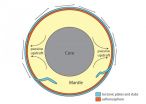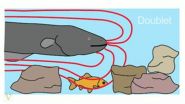(Press-News.org) CORVALLIS, Ore. - Scientists may have solved a long-standing enigma known as the African Humid Period - an intense increase in cumulative rainfall in parts of Africa that began after a long dry spell following the end of the last ice age and lasting nearly 10,000 years.
In a new study published this week in Science, an international research team linked the increase in rainfall in two regions of Africa thousands of years ago to an increase in greenhouse gas concentrations. The study was funded by the National Science Foundation and the U.S. Department of Energy.
The findings are critical, researchers say, because they provide new evidence that increases in carbon dioxide and other greenhouse gases could have a significant impact on the future climate of Africa.
"This study is important not only because it explains a long-standing puzzle, but it helps to validate model predictions of how rising greenhouse gas concentrations might change rainfall patterns in a highly populated and vulnerable part of the world," said Peter Clark, an Oregon State University paleoclimatologist and co-author on the study.
The study was led by the National Center for Atmospheric Research (NCAR). It used computer simulations and analysis of geologic records of past climate.
The researchers focused on the era following the last ice age. When ice sheets covering North America and northern Europe began retreating after the last glacial maximum some 21,000 years ago, there was a long dry spell in central Africa that lasted until about 14,700 years ago, when rainfall increased abruptly. Scientists have long been puzzled by the regime shift, which turned deserts into grasslands and earned the African Humid Period moniker.
Rainfall actually increased in two separate regions of Africa - one north of the equator, the other south. Some previous studies had suggested that the shift may have been triggered by changes in the Earth's orbit, but lead author Bette Otto-Bliesner said orbital patterns alone could not explain increased rainfall of that extent in both regions.
As the Earth emerged from the ice age, atmospheric levels of carbon dioxide and methane increased significantly - almost to pre-industrial levels - by 11,000 years ago. As the planet continued warming, ice sheets melted and the influx of fresh water from North America and northern Europe began weakening the Atlantic Meridional Overturning Circulation, which brings warm water up from the tropics and keeps Europe temperate.
This weakening of the Atlantic ocean current simultaneously moved precipitation southward toward the southernmost part of Africa, and suppressed rainfall in east Africa and northern equatorial Africa during the long dry spell, the researchers say.
When the ice sheets stopped melting, the circulation strengthened and brought precipitation back to the north. This change, coupled with the orbital shift and warming of both the atmosphere and oceans by greenhouse gases, triggered the African Humid Period.
"This study provides yet another demonstration of the sensitivity of the Earth's climate to small changes in atmospheric greenhouse gases," said Clark, a professor in OSU's College of Earth, Ocean, and Atmospheric Sciences.
The science team recreated records of past moisture conditions by examining fossils, former lake levels and other geologic data, and simulated past climate with a power climate model developed by NCAR.
"The future impact of greenhouse gases on rainfall in Africa is a critical socioeconomic issue," Otto-Bliesner said. "Africa's climate seems destined to change, with far-reaching implications for water resources and agriculture in ways that may generate new conflicts."
The study focused on the Sahel region of Africa to the north, including Niger, Chad and northern Nigeria; and the southeastern equatorial region of Africa, including the Democratic Republic of Congo, Rwanda, Burundi, Tanzania and Kenya.
INFORMATION:
A long-held assumption about the Earth is discussed in today's edition of Science, as Don L. Anderson, an emeritus professor with the Seismological Laboratory of the California Institute of Technology, and Scott King, a professor of geophysics in the College of Science at Virginia Tech, look at how a layer beneath the Earth's crust may be responsible for volcanic eruptions.
The discovery challenges conventional thought that volcanoes are caused when plates that make up the planet's crust shift and release heat.
Instead of coming from deep within the interior of the ...
VIDEO:
Vanderbilt biologist Kenneth Catania describes his discovery that the electroshock system used by the electric eel to detect and immobilize prey is uncannily similar to the Taser.
Click here for more information.
The electric eel - the scaleless Amazonian fish that can deliver an electrical jolt strong enough to knock down a full-grown horse - possesses an electroshock system uncannily similar to a Taser.
That is the conclusion of a nine-month study of the way in which ...
The "survival of the fittest" principle applies to cells in a tissue - rapidly growing and dividing cells are the fit ones. A relatively less fit cell, even if healthy and viable, will be eliminated by its more fit neighbors. Importantly, this selection mechanism is only activated when cells with varying levels of fitness are present in the same tissue. If a tissue only consists of less fit cells, then no so-called cell competition occurs. Molecular biologists from the University of Zurich and Columbia University are the first researchers to demonstrate in a study published ...
Since 2010, detections of Asian Carp environmental DNA or "eDNA" have warned scientists, policymakers, and the public that these high-flying invaders are knocking on the Great Lakes' door. Scientists capture tiny DNA-containing bits from water and use genetic analysis to determine if any Asian Carp DNA is present. New research published by Notre Dame scientists shows that the tools currently used for Asian Carp eDNA monitoring often fail to detect the fish. By comparison, the new eDNA methods described in this study capture and detect Asian Carp eDNA more effectively.
The ...
ITHACA, N.Y. - Among the billions and billions of stars in the sky, where should astronomers look for infant Earths where life might develop? New research from Cornell University's Institute for Pale Blue Dots shows where - and when - infant Earths are most likely to be found. The paper by research associate Ramses M. Ramirez and director Lisa Kaltenegger, "The Habitable Zones of Pre-Main-Sequence Stars" will be published in the Jan. 1, 2015, issue of Astrophysical Journal Letters.
Images and study: https://cornell.box.com/infantearths
"The search for new, habitable ...
For nearly 40 years, one of the cornerstones of the study of adaptation has been the examination of "whole-organism performance capacities"--essentially, measures of the dynamic things animals do: how fast they can run; how hard they can bite; how far, fast, and high they can jump; and so on. Together, these functional attributes determine the performance of a species' ecology: the types of food one can eat; the ability to capture or locate prey; the ability to avoid predation; the ability of males to intimidate or, in some cases, prevent rival males from invading a territory; ...
Insects can transmit viral diseases to humans. Therefore, understanding how insects cope with viral infection, and what immune mechanisms are triggered, can be important to stop diseases transmission. In a study published in this week's issue of the scientific journal PLOS Pathogens*, researchers from the Instituto Gulbenkian de Ciencia (IGC; Portugal) now show that the entry route of the virus changes how the insect host responds to it. Using the fruit flies as a model of study, they discovered an immune mechanism that is specifically effective when flies are infected ...
BOULDER - New research demonstrates for the first time that an increase in greenhouse gas concentrations thousands of years ago was a key factor in causing substantially more rainfall in two major regions of Africa. The finding provides new evidence that the current increase in greenhouse gases will have an important impact on Africa's future climate.
The study, led by the National Center for Atmospheric Research (NCAR), is being published this week in Science.
"The future impact of greenhouse gases on rainfall in Africa is a critical socioeconomic issue," said NCAR ...
WASHINGTON - Children in emergency departments can safely be treated for pain from limb injuries using intranasal ketamine, a drug more typically used for sedation, according to the results of the first randomized, controlled trial comparing intranasal analgesics in children in the emergency department. The study was published online last month in Annals of Emergency Medicine ("The PICHFORK (Pain in Children Fentanyl OR Ketamine) Trial: A Randomized Controlled Trial Comparing Intranasal Ketamine and Fentanyl for the Relief of Moderate to Severe Pain in Children with Limb ...
BUFFALO, N.Y. -- Micheal L. Dent, a University at Buffalo psychologist, listens to what is inaudible to others. And what she's hearing might one day help us better understand human hearing loss.
Dent studies ultrasonic vocalizations (USVs) in mice. These sounds are above the human ear's upper limit, but they can be recorded and played back using specialized equipment that has allowed Dent to capture an impressive repertoire that when graphically represented shows a variety of sweeps, arcs, dips and curves. The tempo and intensity of these vocalizations change, as does ...


